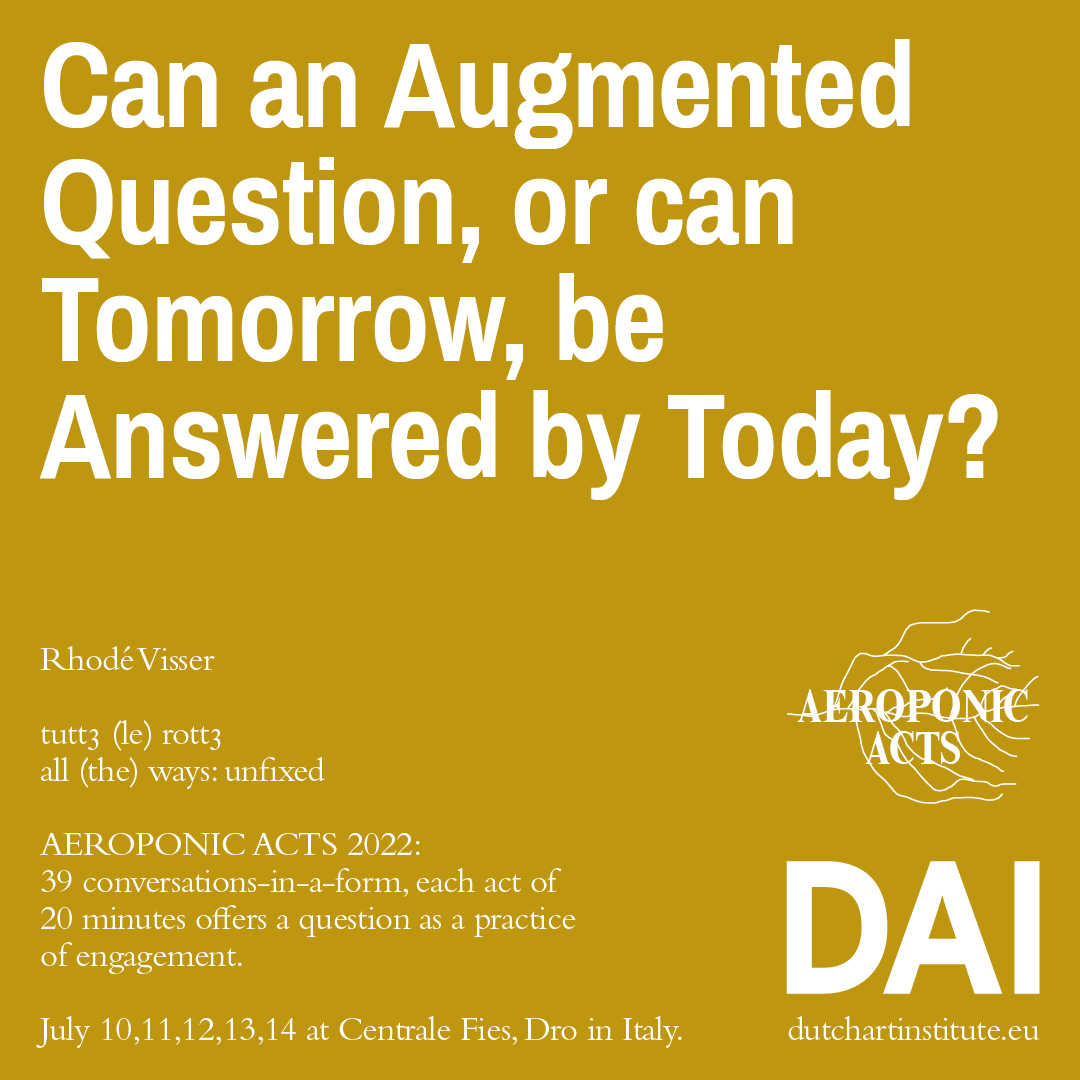Rhodé Visser: 3, 2, 1 What is Seen is Gone
‘Aeroponic’ – root systems nourished by air – Acts is the name given to the nomadic Dutch Art Institute’s final Kitchen presentations. Each participant addresses one question, as a practice of engagement.
Here you will find the documentation of Rhodé Visser's presentation as filmed by Baha Görkem Yalım. The written report is by Hubert Gromny and it includes a summary of the comments by esteemed guest respondents.
3, 2, 1 What is Seen is Gone
Rhodé's question: Can an Augmented Question, or can Tomorrow, be Answered by Today?
Rhodé's introduction: This is how I remembered it
This is how I remember
This is how I
This is how
This is
This
Rendering
Rendering
Rendering
All that is not information, not redundancy, not form and not restraints - is noise, the only possible source of new patterns. – Gregory Bateson (The Parasite)
This is a collection of noisy experimental sounds that make use of environmental sounds and text. The sounds move through realms of non, non-formation and information. At its core are the impulses and distractions that are evoked by a feeling that something is off. It’s about image creation that seems to push forward, while the core is stuck in memory and repetition. The impulses guide the rhythms through memory and disturbances that lead to another form of rhythmic recognition.
Hubert's report: Audience enters a dark space with large-scale projection on the wall screening pink and red flowers among green leaves. The image is still and has an out-of-focus quality with blurry contours. The audience settles in on the stage and the sound from the speakers comes out. Chirping of birds, crickets singing and blowing wind create a quiet ambience which leads to the loud stuttering noise. The noise stays and is interrupted by other sounds of thick volume which resemble dropping of the bomb followed by explosion or the sound of opening a cracking door. The sounds are softened or sharpened by the modulation of the audio and as such relate to the quality of high resolution but blurry image. At certain moments few performers stand up and move within the audience to face the projection and stay still in front of it. Two synthetic or synthetized voices, the one high and another one low, are augmenting the soundscape with the spoken text. The text is distorted and only some fragments can be recognized as words and sentences, these fragments are cues for performers to start and stop moving around the space. With the repetition of certain phrases and fading out of the sound performance reaches its end.
Momtaza Mehri began her response by pointing to the sense of stillness, fixation on the sound and intuitional quality of the performance. These qualities direct to thinking on memory and its organicity, which created a space as an ecosystem. The movement of performers, the still image with its filmic quality and the feeling of postponement of the sounds gave a presentation a movie-like sensation. The stillness and eavesdropping aspect of the text gave it a mournful sense of dealing with cultural damage and its memory. Momtaza noted that the performance was able to create an immersive audio-visual space and it could be interesting to involve the movement of performers more to emphasize its sensorial quality.
Ana Teixeira Pinto referred to the question and the abstract of the presentation to comment on the aforementioned quote from Gregory Bateson. Ana expanded the initial questions related to information theory by invoking Bateson’s definition of information as “difference, which makes a difference” and Erwin Schrödinger’s definition of life as a code—and as such as an information. After introducing these concepts Ana located the piece in a historical moment after 1989 when the digital revolution was announced by the Western political leaders as a time of abundance opposed to the times of scarcity. The performance was operating as an establishment of immersive space created the world of 1989. The still image on the screen evoked the constructs of beauty and harmony, which were used in order to build an eerie environment. Crumbled communication and recurring glitches within the performance lead to think of a double bind of a promise of digital revolution.
Chiara Figone observed the moment when performers were standing still in front of the screen as a point of departure to think of the notion of sensual captivity. The performers seemed to be captivated by the image of flowers, while flowers have a capacity to capture human attention by their scent. In that context the intervention of sound within the space felt to be a modality of construction of sensual memories. The memory which is often presented as something fixed and immutable was exposed as constantly changing through its construction achieved by sonic repetition and distortion. Chiara closed her response by pointing out the potentiality of sound to invoke an image in one's mind and the usage of glitch to distort the order established by the repetition of certain sensual patterns.
Rhodé Visser's "3, 2, 1 What is Seen is Gone" was presented before live audience at the Centrale Fies, Dro, Italy on July 12th.
Find the overview of all 24 AEROPONIC ACTS 2022 here: tuttə (le) rottə - all (the) ways: unfixed


